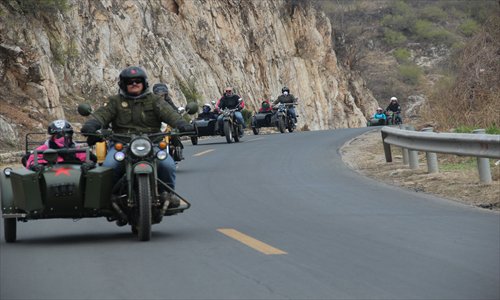Riding into the past

Nothing quite beats hitting the open road for Beijing's sidecar motorcyclists. Photo: Courtesy of Ava Lou
Dan Paulson gently wheels his beloved Chang Jiang (CJ)-750 sidecar motorcycle from his garage ahead of each ride. After turning on the choke, he kick-starts it and the bike's 32-horsepower engine roars to life.
A few powerful revs later, Paulson slowly cruises along his home's alley. His hutong neighbors, as they always do, stop in their tracks and gaze at the vintage motorcycle as it prowls past.
"It's so exciting. When you ride it on the road, people always look twice. It attracts lots of attention," laughs Paulson, who bought his CJ-750 last year.
The bike is a copy of the Soviet Union's M-72, produced from 1942 to 1960, which was inspired by Germany's R-71.
The sidecar motorcycle might evoke military nostalgia, but Paulson says most observers smile when they see him ride around town with his girlfriend at his side.
However, Beijing's sidecar scene isn't dominated by expats alone. A growing number of Chinese enthusiasts are among owners of the more than 2,000 sidecars in the city, says Ava Lou, co-owner of the Chang Jiang Sidecar Shop.
Lou notes that tightening traffic restrictions have made it harder to get behind the handlebars of a sidecar. Most sidecars in Beijing therefore carry out-of-town license plates, although traffic police rarely enforce a ban on the vehicles within the Fourth Ring Road, she added.
Regardless, Lou and fellow sidecar owners prefer hitting the open road for trips to Beijing's outskirts and other scenic spots, including Baiyangdian in Hebei Province.
"I remember in September 2011 an 80-strong group of sidecar riders went to Miyun county. Our giant pack was very impressive. It was a scene itself to behold on the road," she says.
Prices for used sidecars start at around 40,000 yuan ($6,525), with those sold at Lou's dealership coming in a variety of shapes and models dating from the 1940s to 1980s. Most CJ sidecars she sells were produced by the People's Liberation Army or affiliated sidecar makers.
Guang Li, 59, is regarded a legend of Beijing's sidecar scene. A three-wheeled enthusiast since 1966, he was among 314 sidecar motorcyclists who set a Guinness World Record in Beijing in 2004 for the largest parade of such vehicles.
"Sidecars are a lifestyle, not a mode of transportation," he claims. "It's like collecting antiques or artwork that you can drive on the road."
Sam Hopper, 47, a teacher who moved to Beijing from New York in 2003, founded TRI Beijing Sidecar Motorcycle Tours in 2010. He notes sidecar owners who only ride on weekends typically spend around $750 annually on gas and maintenance.
Hopper, a nine-year sidecar motorcyclist in Beijing, is fascinated by the vehicles' rich history and the culture.
"Seeing the Germans riding around on their sidecar motorcycles [in World War II-era movies] you think, 'Wow, I've got one of those.' It's a neat feeling. These bikes have been around a long time," he says.
Hopper bought a sidecar because he believed it was safer than getting around Beijing on a regular bicycle.
"When I was in New York, I wanted to ride motorcycles. But when I came to Beijing, the bikes were smaller and different. Sidecars were a safer option for me since they are bigger," he says.
"It's far more different [riding a sidecar] than driving a car. You have the cool wind in your face … and the power underneath you. It's the sound, the vibration, the feel. It's like a bicycle and car at the same time."
Evelyn Cheng contributed to this story